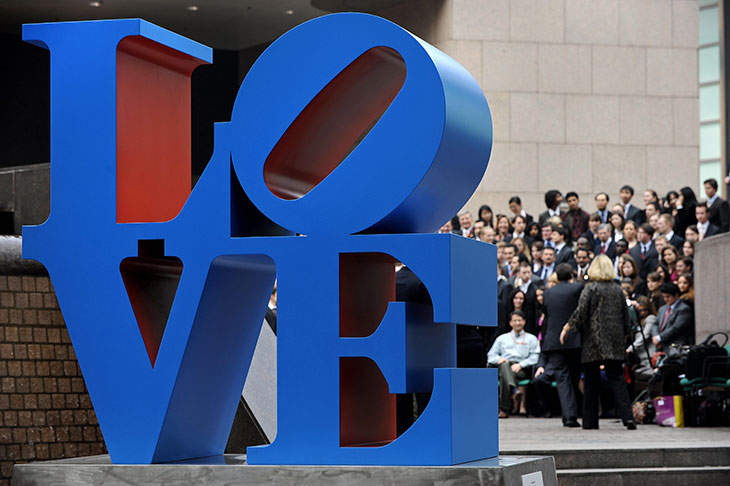Robert Indiana’s LOVE is beloved the world over. People know the image who don’t know Indiana’s name, his other work, or even the English language. Valorised initially as an emblem of the 1960s cultural revolution, LOVE has become a symbol of unconditional affection and brotherhood.
These associations differ markedly from Indiana’s original intentions. Born out of wedlock, he was adopted as an infant by Carmen and Earl Clark, a couple hit hard by the Depression. He grew up poor, in a world he called ‘bleak, cheap and tawdry’. He described his adoptive parents as members of the lost generation whose dream of upward mobility turned out to be hollow. To ‘distract themselves from any meaningful aspects of their lives’, they spent their time travelling from one grubby bar and roadside café to another. On these excursions, Indiana was introduced to a mythic America he dreamed of one day inhabiting – one whose optimism and confidence were embodied for him in the bold advertising signs that lined the interstate highways of his home state of Indiana.
Indiana made his first foray into that world in 1958, abandoning the surname ‘Clark’ in favour of an identity that asserted his Midwestern roots. As Robert Indiana, he drew on his autobiography to craft an art whose dazzlingly bold and visually kinetic surfaces communicated the ebullience of post-war America while simultaneously exposing the country’s dark history of avarice, materialism and racial injustice. His appropriation of the seemingly cheerful and reassuring language of mass advertising to communicate the themes of sin, love, death, and forgiveness was spellbinding. By 1963, Indiana was being heralded as one of the leading figures of the Pop art generation.
Indiana’s fortunes changed dramatically with his creation of LOVE. For him, the image contained the same union of celebration and criticism that marked his other work. His family had never used the word love and his adult relationships had made him wary of the fragility and precariousness of affection. ‘Love is a dangerous commodity – fraught with peril,’ he once said. ‘Inevitably the embers go out.’ By tilting the ‘O’ in LOVE, he sought to introduce a degree of scepticism into the concept and to critique the sentimentality associated with a word that, for him, signalled pain and loss.
Over time, however, the success of LOVE caused Indiana to embrace the public’s perception of the composition as an emblem of emotional fidelity and fellowship. To the distress of the art world, he regularly recycled the image, making myriad LOVE paintings and large edition prints and overseeing the fabrication of LOVE sculptures in multiple sizes, some in as many as eight different colours. It was as if Indiana felt he could have it both ways: be a people’s artist while remaining valued as an aesthetic innovator. The calculation backfired. Now, however, a reappraisal of his art seems to have begun, rightfully re-establishing him as a major American artist of the ’60s – one who harnessed deceptively simple words and the immediacy of vernacular signage to explore the fundamental issues facing humanity.
Barbara Haskell curated the Whitney Museum of American Art’s retrospective exhibition ‘Robert Indiana: Beyond Love’ in 2013.
